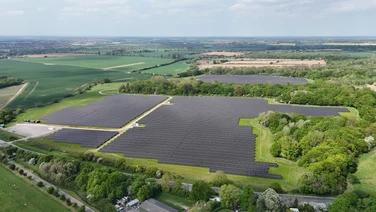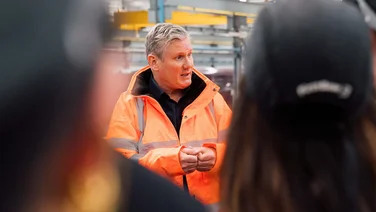The climate crisis is the biggest threat humanity has ever faced, make no mistake. Any hint that we could potentially reverse its catastrophic effects on our planet would be welcome.
We’ve looked into whether it’s possible to reverse climate change, and if so, the methods we could use to turn the tide.

Is it possible to reverse climate change?
Yes, but it wouldn’t be easy (understatement of the century). We’d need vast amounts of infrastructure, planning, funding, and — perhaps most importantly — willpower to even begin the incredibly complicated process of reversing climate change.
Climate change has happened throughout the history of Earth, but these climate cycles have occurred naturally — and typically over thousands of years, if not millions.
It’s human-made climate change that’s caused so much concern, as we’ve altered weather systems, ecosystems, and temperatures at a frightening pace.
Finding a solution to stopping and reversing this cataclysmic process is the biggest challenge our species — and the majority of life on this planet — faces today.
Where are we now with climate change?
Global average temperatures have increased by 0.74 degrees Celsius since the 1800s, thanks to the vast amounts of pollution introduced to the atmosphere. This temperature rise is leading to more deadly natural disasters and extreme weather events across the planet.
The Industrial Revolution is largely to blame, with the introduction and expansion of fossil-fuel guzzling factories belching an estimated 1.5 trillion tonnes of CO2 into the atmosphere.
CO2 is the main cause of climate change. In 2021, the NOAA Global Monitoring Lab found that two-thirds of the total heating influence from human-produced greenhouse gases came from CO2.
CO2 damages the world’s oceans too, accelerating the widespread ocean acidification threatening marine life on an unprecedented scale. The sea absorbs CO2 from the atmosphere, sort of like the fizz in a can of cola, and it reduces the water’s pH level.
The water’s acidity increases as its pH level falls, causing all sorts of nasty side effects for ocean life, such as weakening sea snails’ shells and bleaching coral reefs. Warming oceans also drive fish further north, depleting fishing stocks for communities that rely on them for food.
And weather systems are shifting as a result of climate change, with extreme weather incidents occurring more frequently. Freak storms, record heatwaves, and increasingly damaging droughts have all been conclusively linked to human-made climate change.

How to reverse the effects of climate change
There are hundreds of proposed solutions that claim to reverse the effects of climate change — some realistic, some farfetched, and some a little too optimistic.
We’ve focused on the solutions we believe are the most realistic and effective.
Expanding wind farms
Only around 5–6% of the world’s electricity comes from wind, but its potential is enormous. Using just 1.9% of the ocean’s total area for offshore wind would meet the entire planet’s electricity needs.
Wind’s intermittent nature will always count against it however, so it’s not feasible to use it to entirely replace all other methods of generating electricity.
The number of wind farms operating still needs to be expanded massively though, because it’s one of the best ways of reducing carbon emissions.
If wind accounted for just over 20% of the world’s electricity generation, nearly 84 gigatonnes (84 billion tonnes) of CO2 would be reduced by 2050. That’s 8.6% of total global emissions by 2050 — not enough, but a start.
Introducing enough wind power to significantly reduce carbon emissions wouldn’t actively reverse climate change, but would help slow it down. Ultimately, enough renewable energy sources would stop the process, allowing the Earth to then reverse it.
Eating fewer animal products
Raising livestock for food and animal products (like milk and cheese) produces just under 15% of global greenhouse gas (GHG) emissions.
Reducing our consumption of animals and animal products is paramount to shrinking CO2 emissions. If we did make the switch to an entirely plant-based diet, the impact would be astonishing.
Rapidly phasing out animal agriculture could not only stabilise GHG emissions for 30 years, it would offset 68% of CO2 emissions this century. It’d also free up much more room for carbon-absorbing methods like growing vegetables.

The most damaging GHG from livestock farming is methane, which has up to 80 times the warming potential of CO2 over the first 20 years it spends in the earth’s atmosphere. Cows are the biggest offenders — if they were a nation, they’d be the third-largest GHG emitters globally.
So limiting or even stopping meat and animal product consumption would be a win-win: it’d reduce methane emissions from livestock while also removing CO2 released in agricultural infrastructure.
Widespread solar power
Solar power has exploded in popularity around the world, even in countries like the UK where the sun often hides away — 1.2 million UK homes now have solar panels installed, meaning an annual CO2 reduction of roughly 840,000 tonnes.
This is great news for the climate, and if all UK households switched to solar power, we’d emit 19.6 million fewer tonnes of CO2 each year.
And despite the fact that producing solar panels does emit some CO2, the carbon payback period is actually remarkably short.
Solar panels owners can make their panels carbon neutral after an average of three years of owning them — and this period will continue to shrink.
Building more solar farms is essential too, especially as they can provide power to homes and communities unable to easily install residential solar panels. See the world’s progress with large-scale solar by checking out our list of the largest solar farms in the world.
Restoring rainforests
Rainforests are often called the “lungs of the planet”, because of their powerful ability to absorb vast amounts of CO2 — the Amazon rainforest alone absorbs 1.5 billion tonnes of CO2 every year, equivalent to 4% of all fossil-fuel emissions.
It’s a big issue when they keep getting cut down to make way for agriculture, or so their trees can be used for furniture and construction.
Restoring rainforests is one of the most effective ways to remove CO2 from the atmosphere, and store it so it’s released gradually, at a natural rate.
Two-thirds of human-made carbon emissions could be captured if we restored and added 2.2 billion acres of tree cover to depleted rainforests — roughly 185 billion tonnes of CO2.
Much higher taxation for high emitters
100 companies are responsible for 71% of all GHG emissions, which makes a mockery of the idea that climate change is mostly about personal responsibility.
Convincing people to reduce their carbon emissions is still a good thing, but it’s huge multinational companies that are causing the bulk of damage to the planet.
The best way to get corporations to reduce their emissions is to hit them in the place it affects them the most: their bottom line. Higher taxation of emissions is already a proven way to get companies to clean up their act, so it’s something governments have to get braver at.
What’s more, countries with higher carbon taxes — and lower emissions as a result — aren’t driving away companies. Many of the countries imposing the strictest carbon taxes have extremely healthy economies and high GDP-per-capita rates.
When will climate change become reversible?
Climate change could begin to reverse by 2050 if drastic actions are taken now. Otherwise, the risk of runaway climate change that spirals beyond our ability to control it will become an unavoidable reality.
It’s important to stress that we don’t mean climate change stabilisation or limited global warming; we mean reversal.
We’ve covered more clever ways to reverse the effects of climate change if you’re keen to learn about some of the more cutting-edge methods — plastic-eating mushrooms are up there with the strangest solutions!
Summary
As promising as all these solutions sound, it’s essential to remember none of them are silver bullets that’ll cure all of our climate change woes. There’s no single or even collection of options that we can pick and choose from to fix the issue entirely.
Humanity needs to work together to enact a range of policies in parallel to each other instead. We must create more renewable energy sources, institute much higher taxation of fossil-fuel companies, and restore natural habitats such as rainforests at the same time.
There is hope, and if there is the will to act on climate change, the world could be a much brighter place for generations to come.
As things stand, the UK is getting warmer every year. But does global warming mean UK homes now need aircon? Go to our page to find out.






